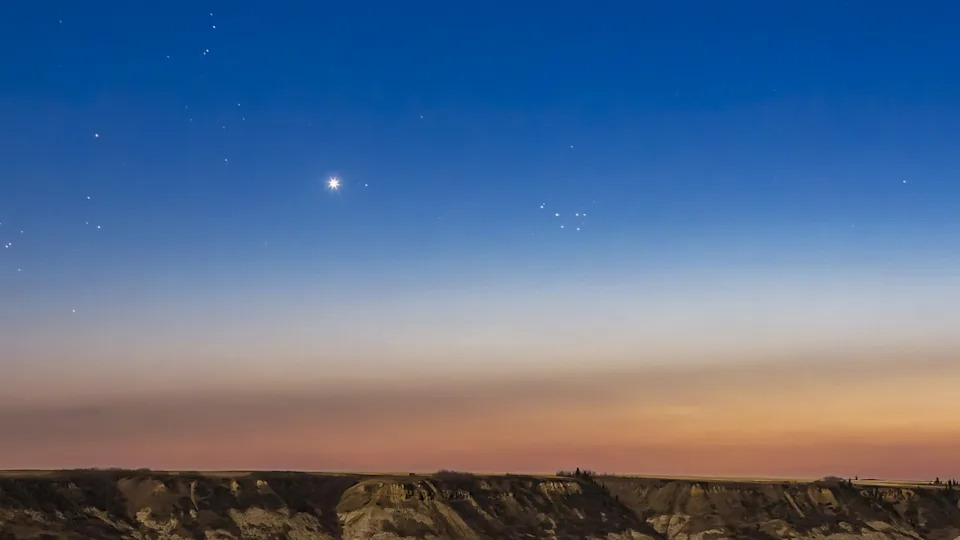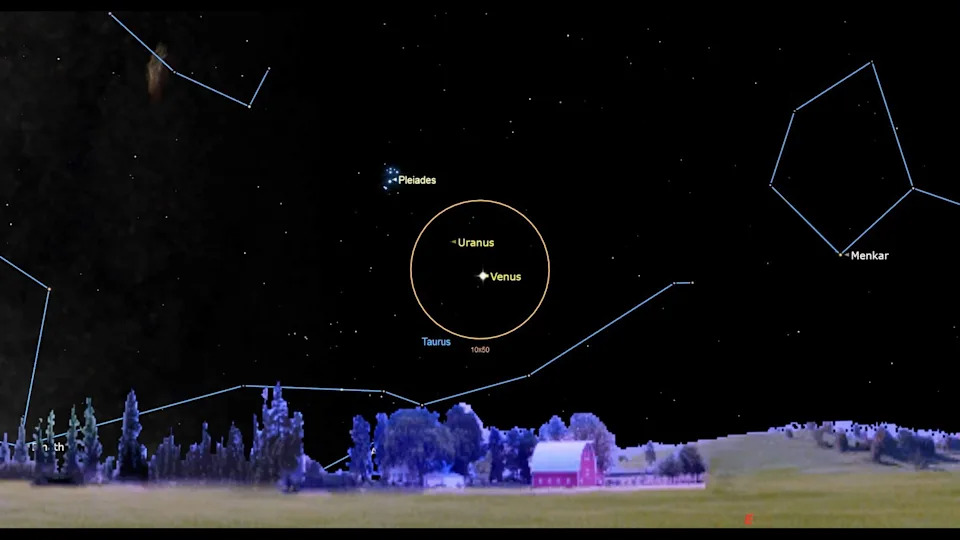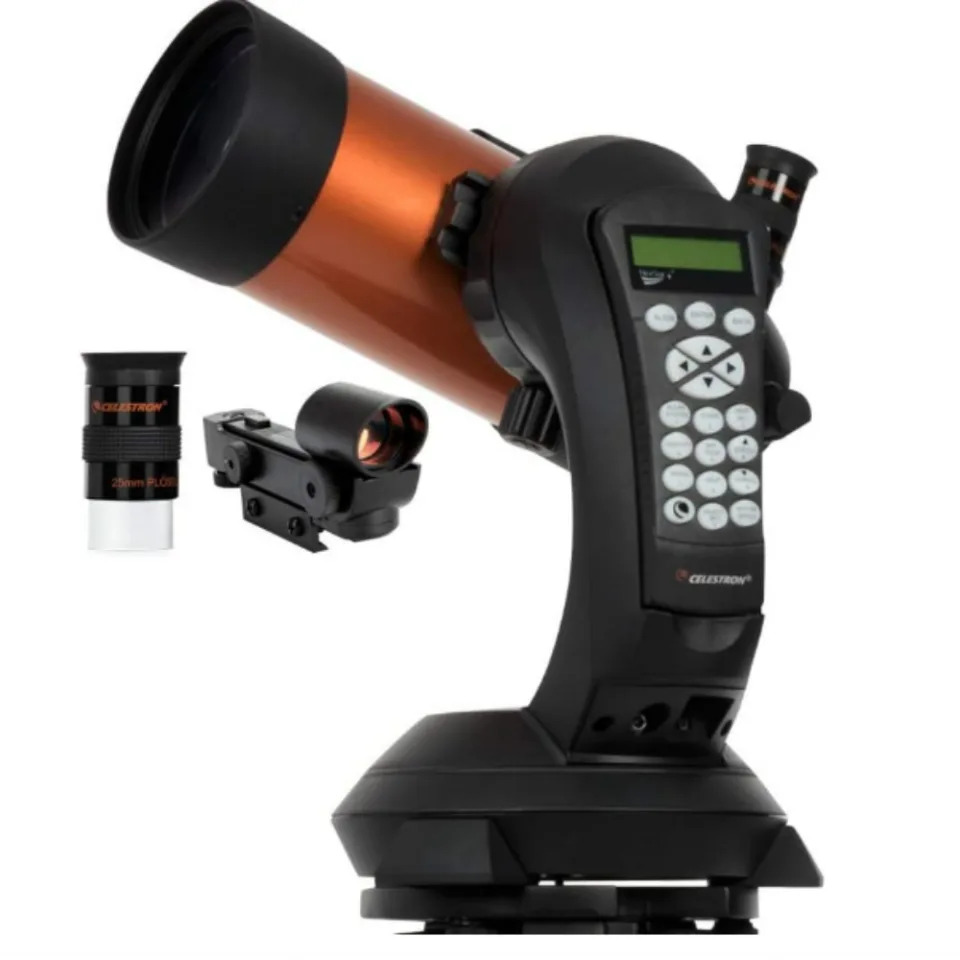Don't miss the Pleiades shine with Venus in the predawn sky on July 5
When you buy through links on our articles, Future and its syndication partners may earn a commission.
 Venus will appear as a bright morning star close to the 'Seven Sisters' of the Pleiades open cluster. | Credit: Alan Dyer/VW Pics/UIG via Getty Images
Venus will appear as a bright morning star close to the 'Seven Sisters' of the Pleiades open cluster. | Credit: Alan Dyer/VW Pics/UIG via Getty ImagesEarly risers are in for a celestial treat on July 5, when Venus appears as a bright 'morning star' alongside the magnificent Pleiades open star cluster in the eastern sky just before dawn.
Stargazers in the U.S. can see Venus rising around 3 a.m. local time, with the Pleiades star cluster visible as a smudge of light under dark sky conditions less than 7 degrees to Venus' upper left. To estimate that distance, hold a clenched fist at arm's length; it spans roughly 10 degrees of sky.
The cosmic duo will be visible for around two and a half hours before the glare of the rising sun hides the Pleiades from view. While the cluster is known to contain a multitude of blue-white stars, our naked-eye view of the Pleiades from Earth is largely dominated by its seven brightest members : Alcyone, Asterope, Celaeno, Electra, Taygete, Merope and Maia. The light from these stars is best viewed away from city lights and becomes easier to detect when the star cluster is in the periphery of your vision, where the cells that excel at night vision are at their densest.
The seven brightest stars can be picked out using a pair of 10x50 binoculars, while a telescope with an aperture of 4 inches or greater will reveal more of the cluster's thousand-strong stellar population.
 See Venus close to the Pleiades in the predawn hours. | Credit: Chris Vaughn
See Venus close to the Pleiades in the predawn hours. | Credit: Chris VaughnVenus, meanwhile, is stunning to view with the naked eye alone, shining at magnitude -3.9. However, pointing a telescope with an aperture of 2.4 inches or greater with a magnification of 50x or more will allow you to pick out its moon-like phases, according to telescope-maker Celestron.
TOP TELESCOPE PICK:
 Celestron - NexStar 4SE Telescope
Celestron - NexStar 4SE TelescopeWant to see the planets of our solar system for yourself? The Celestron NexStar 4SE is ideal for beginners wanting quality, reliable and quick views of celestial objects. For a more in-depth look at our Celestron NexStar 4SE review.
But wait, there's more! The ice giant Uranus is also present in the sky on July 5, positioned almost directly between Venus and the Pleiades. However, its relatively dim magnitude of +5.8 makes it incredibly challenging to spot with the naked eye. Remember, magnitude is the system astronomers use to keep track of how bright an object appears in our night sky. The lower the number is, the brighter the object. The human eye is capable of spotting objects brighter than magnitude +6.5 in dark sky conditions.
To see Uranus' tiny aqua disk you'll need a telescope with an 8-inch aperture. However, even then it will appear as little more than a blue point of light hanging against the starfield beyond.
Editor's Note: If you capture a picture of Venus with the Pleiades and want to share it with Space.com's readers, then please send your photo(s), comments, name and location to [email protected].
An astronomical spectacle to behold: the glory of Pleiades glowing under a predawn sky adorned by Venus's luminous presence on July 5, an event not-to be missed for stargazers worldwide.
An unforgettable celestial spectacle awaits on July 5th as the Pleiades twinkle alongside Venus in a predawn display - an event not to be missed by any astronomy enthusiast! The convergence of stars and planets promises a timeless beauty that captures our collective wonder.
The pre-dawn skies on July 5 promise a breathtaking spectacle as the Pleiades twinkle alongside Venus, an unforgettable celestial dance not to be missed!
A nocturnal treat not to be missed: The brilliant conjunction of the Pleiades cluster with Venus gracefully illuminating the predawn sky on July 5, a celestial spectacle that promises an unforgettable twilight experience for stargazers.
An awe-inspiring sight awaits on July 5, where the splendid Pleiades steal the show alongside a serene Venus in predawn skies - an astronomical treasure trove not to be missed!
The conjunction of the Pleiades shimmering with Venus in predawn skies on July 5th is a spectacular celestial spectacle not to be missed, offering skygazers an unparalleled opportunity for awe-inspiring views.
The pre-dawn spectacle on July 5th, as the radiance of Pleiades bathes in harmonious conjunction with Venus's twinkle—a celestial display not to be missed.
An exhilarating snippet, stating the time and night sky's cosmic convergence trap: On July 5th predawn hours witness a rare interplay of Pleiades stars with Venus - an orbital spectacle not to be missed for astronomy enthusiasts everywhere.
Embrace the celestial spectacle of July 5th, when lovers of astronomy can witness a stunning fusion as Venus shines bright alongside Pleiades stars in predawn skies - an event not to be missed!
The celestial spectacle of the Pleiades twinkling alongside Venus in predawn skies on July 5th promises an unforgettable exclamation point to a summer sky filled with wonders.














